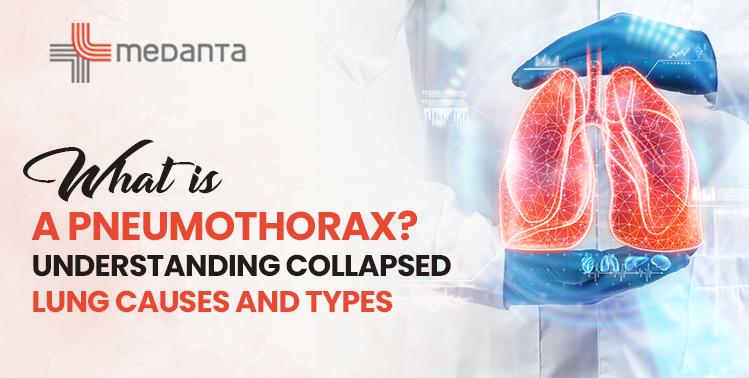CH Baktawar Singh Rd, Medicity, Islampur Colony, Sector 38, Gurugram, Haryana 122001

22 May, 2025
adminBreathing is something most of us take for granted, but the lungs are delicate organs that can be affected by a range of health problems. One such condition is pneumothorax, commonly known as a collapsed lung. Though it might sound scary—and it can be serious—it is a condition that doctors understand well and can often treat effectively.
In this Dr Harsh Vardhan Puri blog, we’ll break down what pneumothorax is, its causes, the different types of pneumothorax, how it is diagnosed, and the options available for treatment and recovery.
A pneumothorax happens when air escapes from the lungs and gets trapped in the space between the lung and the chest wall, known as the pleural space. This trapped air puts pressure on the lung, which can cause it to partially or completely collapse. When a lung collapses, it cannot function properly, making it difficult to breathe and get enough oxygen into the bloodstream.
The condition can affect one or both lungs and can happen suddenly or develop over time. Pneumothorax can be a medical emergency, depending on its size and the symptoms it causes.
There are many pneumothorax causes, and they can vary from person to person. The condition may develop without a clear reason, especially in healthy people, or it might result from an injury or illness. Here are some common causes:
Understanding the different types of pneumothorax helps in diagnosing and choosing the right treatment. The condition is generally classified into the following types:
The symptoms of pneumothorax can range from mild to severe, depending on how much of the lung has collapsed and the individual’s overall health. Common signs include:
In some cases, especially with a small pneumothorax, there may be few or no noticeable symptoms.
To diagnose a pneumothorax, doctors usually start with a physical exam and listen for abnormal chest sounds. The diagnosis is confirmed using imaging tests such as:
The treatment for pneumothorax depends on the size of the collapse, its cause, and the patient’s symptoms. Options include:
Also Read: What Is Pneumothorax Surgery Cost In India?
Recovery from a pneumothorax varies based on its type and cause. In general:
To prevent another episode, doctors may advise lifestyle changes like quitting smoking, avoiding high altitudes or scuba diving, and possibly undergoing surgical procedures if the risk of recurrence is high.
Most people recover fully from a pneumothorax, especially when it is treated promptly. However, regular follow-up and imaging tests are important to make sure the lung has healed completely.
Pneumothorax, or a collapsed lung, is a condition that can range from mild to life-threatening. It occurs when air enters the space between the lung and the chest wall, causing the lung to collapse. There are different types of pneumothorax, and knowing the cause helps guide treatment. Whether due to an injury, lung disease, or spontaneous rupture, quick diagnosis and proper treatment can lead to full recovery in many cases.
Understanding the symptoms of pneumothorax, such as sudden chest pain and trouble breathing, is key to getting timely medical attention. With modern medical care, even serious cases can often be managed effectively.
If you or someone you know ever experiences symptoms that could point to a collapsed lung, don’t wait—seek medical help right away. Your lungs are vital, and taking care of them is one of the most important things you can do for your overall health.
Category : Pneumothorax
Tags: